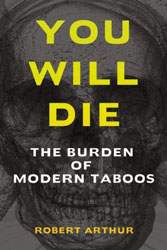Posted: October 5th, 2011 | Filed under: addiction, alcohol, amphetamine, cocaine, drugs, gambling, marijuana, tobacco | 2 Comments »
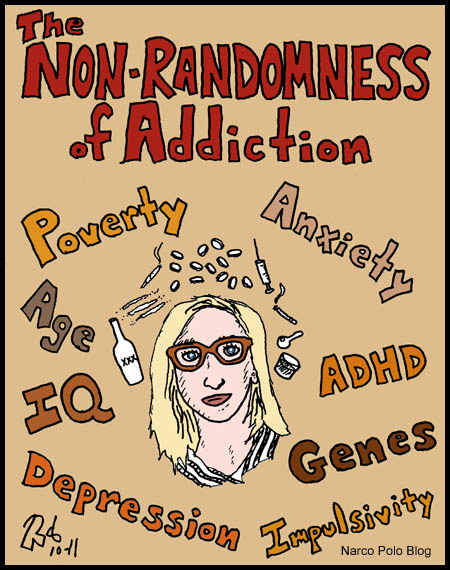
A tenet of the drug war is that drug X is so pleasurable that once tried, most people cannot resist it. There is no way of knowing if you have the “disease” of lifelong addiction to drug X, therefore no one should ever try drug X. All of this is wrong.
The vast majority of people who try drugs do not go on to become addicted (1, 9), and those that do tend to share certain characteristics and conditions. Here are some of the things that predispose people to addiction:
Other Addictions
If a person has not been able to exercise self-control with one source of pleasure, it is more likely he or she will not be able to exercise self-control with another source of pleasure. As can be seen in the following chart, someone diagnosed with a cocaine dependence is 6.64 times more likely than someone without a cocaine dependence to develop a dependence to alcohol.
 (6)
(6)
This overindulgence is not reserved to drugs as demonstrated by the considerable overlap of drug addictions and behavioral addictions. Note that the percentage of the general population that has ever experienced substance use disorders is 14.6%. (5)
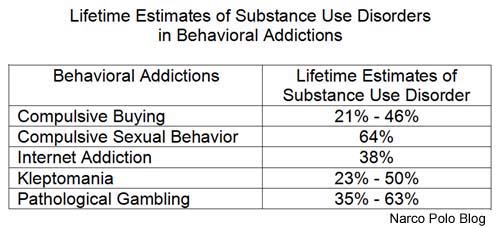 (2)
(2)
Although overlap with food addiction is complicated by drugs’ effects on weight (e.g. cigarettes and stimulants suppress appetites), 32.6% of weight-loss surgery candidates have experienced substance use disorders. (4)
Poverty
Surveys of drinking have long found that despite being more likely to abstain, those from lower socioeconomic groups are still “much more often” problem drinkers. (10, p. 160) A more recent study has found income serves as a predictor for more than just alcohol dependence. As seen below, people in the poorest income bracket are almost three times as likely to become dependent on cocaine as those in the wealthiest bracket.
 (6)
(6)
Mental Health Issues
People with mental health issues are more likely than their peers to become addicted to substances. As can be seen below those diagnosed with ADHD or a personality disorder are three times as likely to become dependent on alcohol.
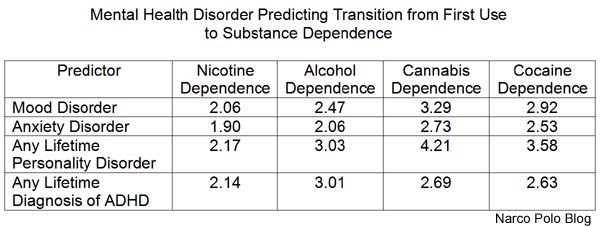 (6)
(6)
Lower Intelligence
Heavy drug users frequently score lower on cognitive tests than their peers. This has been used to say drugs lower intelligence. In the early 2000s two twin studies disproved this idea. In these studies one twin had a history of drug abuse and the other did not. Neither study found a correlation between cognitive performance and amount of drug use. The studied drugs were marijuana, cocaine, and amphetamine. Lower cognitive abilities lead to heavy drug use, not vice versa. (3, pp. 150-152)
Genes
An adoption study has shown that the biological father’s drinking patterns predict a son’s alcoholism, while the adoptive father’s does not. Boys whose biological fathers were severe alcoholics had an alcoholism rate of 18% with an alcoholic adoptive father, 17% with an adoptive home free of parental alcoholism. A study of twins found shared genes did not correlate with experimentation with illicit drugs, but if an identical twin was dependent there was a 40% chance the twin was also dependent. (3, p. 92)
Addictive Personality
People with substance use disorders, just like people with behavioral addictions, score high on self-report measures for sensation-seeking and impulsivity, and low for harm avoidance. (2) This is not surprising. An addict is arguably someone who chooses the sensation an activity provides at levels that are harmful. The choice is influenced by his or her impulsivity, i.e. the tendency to act without weighing the future consequences of one’s actions. The pleasure an addictive behavior provides is immediate whereas the pleasure of moderation is often distant and abstract (e.g. long-term health, more stable work/family life).
Youth
Not only are older people much less likely to become dependent on something, they are also more likely to end dependencies. The vast majority of addicts “mature out” of their addictions and most of them accomplish this without treatment. (11, p. 13) Maturing out is so pervasive that a national 2010 survey found that only .1% of people 65 or older had abused or been dependent on an illegal substance in the past year. The highest level was reached by 19-year-olds (9.3%) from which the number decreased with each ensuing age category. (8)
 (6)
(6)
In line with this, addictive personalities weaken over time. Older adults report being less impulsive, sensation-seeking, and risk tolerant than their younger peers. (12)
Conclusion
Addiction is an intense involvement people fall into for solace when they cannot find better gratifications in the rest of their lives. (11, p. 16) The escape provided by destructive behaviors is usually only appealing to those suffering from internal sources, e.g. mental health issues, or external sources, e.g. poverty. Addiction is a symptom of underlying problems. This helps explain why, contrary to the exhortations of America’s drug warriors, the legal status of drugs has been found to have “surprisingly little measurable consequence” on factors like addiction rates. (7, 3, p. 3) The locus of addiction lies in people, not substances.
Sources
1. Robert Arthur, You Will Die: The Burden of Modern Taboos, 3rd Ed. (2008), p. 330.
2. Jon Grant, et al., “Introduction to Behavioral Addictions,” American Journal of Drug and Alcohol Abuse, 36, 2010.
3. Gene Heyman, Addiction: A Disorder of Choice (2009).
4. Melissa Kalarchian, et al., “Psychiatric Disorders Among Bariatric Surgery Candidates,” American Journal of Psychiatry, Feb. 2007. LINK
5. Ronald Kessler, et al., “Lifetime Prevalence and Age-of-Onset Distributions of DSM-IV Disorders in the National Comorbidity Survey Replication,” Archives of General Psychiatry, 62, 2005.
6. Catalina Lopez-Quintero, et al., “Probability and Predictors of Transition from First Use to Dependence ….,” Drug and Alcohol Dependence, 115, 2011.
7. Robert MacCoun and Peter Reuter, Drug War Heresies (2001), pp. 236-237.
8. “National Survey on Drug Use and Health,” Fig. 5.3B, Substance Abuse and Mental Health Services Administration (SAMHSA), 2010. LINK
9. Frank Owen, No Speed Limit (2007), p. 48.
10. Stanton Peele, Diseasing of America (1995), p. 160.
11. Stanton Peele, Seven Tools to Beat Addiction (2004).
12. D.R. Roalf, et al., “Risk, Reward, and Economic Decision Making in Aging,” Journals of Gerontology, 6 Sep. 2011. LINK
Posted: September 8th, 2011 | Filed under: drugs, tobacco | 14 Comments »
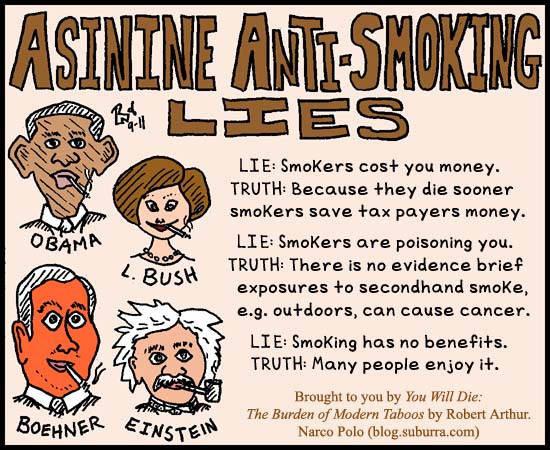
Smoking is unhealthy. Preventing juveniles from smoking and protecting non-smokers from secondhand smoke in confined spaces are reasonable responses, but the ever increasing demonization and discrimination is becoming morally repugnant. Smokers are increasingly being banned from open-air public places, denied employment, obscenely taxed, and driven underground. Politicians and bureaucrats disguise these cruel and bigoted headline-grabbing stunts as caring heroic acts by using the following lies:
Smokers Cost You Money
When calling for more punitive laws anti-smokers love to trumpet smokers’ healthcare costs. This is a canard. Non-smokers die earlier and therefore do not take advantage of Social Security, Medicare, or pension plans to the extent that non-smokers do. In addition, smokers are more likely to die of relatively quick diseases such as lung cancer, as opposed to lingering ones such as Alzheimer’s and Parkinson’s. Numerous studies have found that smokers cost tax payers substantially less than non-smokers. (9, 15) A 2008 Dutch study found that health care costs for smokers were about $326,000 from age 20 on, compared to about $417,000 for thin and healthy people. (15) A Canadian study found that in 1986 smokers added $1.4 billion to the pension system by their premature deaths. (6)
Smokers Are Poisoning You with Secondhand Smoke
Secondhand smoke in a confined space is unhealthy. However, the exaggeration of its risk is ridiculous, and the hyping of the dangers of fleeting outdoor exposure are asinine.
We know the sun causes skin cancer but people with common sense realize that does not mean walking down the street will give you cancer. We know being obese can cause heart attacks but that does not mean eating a cheeseburger is unsafe. Yet when it comes to secondhand smoke, even our Surgeon Generals make these moronic exaggerations. (For examples see this LINK and this LINK.)

* Graph uses 20% increase in risk to spouses of smokers. (4, 14)
Many of the spouses in the above study were chronically exposed to smoke in confined spaces for decades and yet their risk is nowhere near that of smokers. As for people whose only exposure to secondhand smoke is catching the occasional whiff, there is no evidence that brief intermittent exposures to smoke cause cancer. (8) Cardiovascular disease requires years of chronic exposure as well.
Smokers Are Poisoning You with Thirdhand Smoke
Thirdhand smoke is smoke left behind on surfaces. The idea is that someone who stands next to someone who smokes will spread cancer via their clothes for the rest of the day. As one thirdhand article warns, “young children are apt to suck on a parent’s clothes.” (5)
The “science” behind thirdhand smoke dangers should repulse anyone who has a puff of integrity. This year Dr. Virender Rehan and his team of investigators directly applied known tobacco carcinogens to removed fetal lung tissue and observed damage. From this he deduced that thirdhand smoke was dangerous and, I’m not making this up, declared that the harm to people cleaning sheets from smokers’ hotel rooms is a global problem. (7, 10)
The issue with thirdhand smoke is not whether smoke is bad, it is how can harmful levels of it fly off of smoke-touched surfaces and get in peoples’ lungs. Applying orange juice directly to lung tissue would cause damage, but that does not mean that smelling orange juice is dangerous. Rehan’s silly study had nothing to do with thirdhand smoke but still made international headlines. UPI’s read “‘Thirdhand’ Smoke Hurts Infant Lungs.” (13)
Smoking Has No Benefits
The meddling whingers who want to force their notions of proper behavior on others rarely consider other peoples’ notions of happiness. Anti-smokers are no different. Cigarettes do bring people pleasure. The journalist Christopher Hitchens wrote in 1994 about his chain-smoking, “cigarettes improve my short-term concentration, aid my digestion, make me a finer writer and a better dinner companion, and, in several other ways, prolong my life.” (12) In 2011, after contracting esophageal cancer, he said that he had knowingly taken a risk with his lifestyle and that he would do it again if he had the opportunity. (2)
Although the cancer risks greatly outweigh the positive effects, cigarettes do have health benefits. Non-smokers are twice as likely to be obese, and three times as likely to be severely obese. (11) Smoking is also linked to lower risk for Parkinson’s disease, endometriosis, ulcerative colitis, Kaposi’s sarcoma, and atopic disorders such as allergic asthma. (A list of supporting studies can be found at Wikipedia’s “Health Benefits of Smoking” page.)
Hypocrisy
Many politicians who ban smokers in parks for public health reasons hypocritically ignore the real cancer risks imposed on us by drivers and corporate polluters. Being in a confined space with a running car will actually kill you and the auto belching in cities dwarfs the gaseous output of smokers. Smog’s “deadly” effects are well known and yet the President recently decided not to further regulate it against the advice of the EPA.
There are scant differences between the physics and chemistry of tobacco smoke and smoke created from burning any biomass. (1) For example, burning wood emits significant amounts of pollutants and carcinogens. (3) Despite this, people are rarely irate about burning candles, tiki torches, lanterns, campfires, and barbeques. The reason is that, just like with cigarette smoke, outdoor exposure is usually trivial.
Sane Voices
Dr. Michael Siegel has worked at the Office on Smoking and Health at the CDC, has published over 70 papers related to tobacco, and has been an important advocate in the movement to ban indoor smoking for over 25 years. In 2005 he started the blog The Rest of the Story to counteract the tobacco control movement’s loss of integrity and its growing bigotry and discrimination against smokers themselves. His posts discredit the numerous lies told by the government and anti-smoking groups in their never-ending pursuit of stricter prohibitions.
Christopher Snowdon is the British author of Velvet Glove, Iron Fist: A History of Anti-Smoking. His blog of the same name counters junk science, junk journalism, and junk propaganda directed against smokers.
Their work made this post possible. I salute Dr. Siegel for choosing integrity over political opportunities and I salute Mr. Snowdon for introducing me to the priceless Daily Show clip below.
The Daily Show’s Take on NYC’s Smoking Ban (6/20/11)
“Are you fucking kidding me? Smoking? Smoking?” Samantha Bee to a meddling whinger
Bonus Link
A photo shoot of a stylish young Barack Obama smoking. LINK
Sources:
1. Simon Chapman (Professor of Public Health, University of Sydney), “Going too Far? Exploring the Limits of Tobacco Regulation.” PDF LINK
2. Jack Mirkinson, “Christopher Hitchens: Despite Cancer, I’d Drink & Smoke Again,” HuffingtonPost.com, 17 Aug. 2010. LINK
3. Luke Naeher, et al., “Woodsmoke Health Effects: A Review,” Inhalation Toxicology, 2007. PDF LINK
4. Office of the Surgeon General, “Health Consequences of Involuntary Exposure to Tobacco Smoke,” 2006. LINK
5. Lynne Peeples, “Your Nose Knows: The Invisible Threat of ‘Thirdhand Smoke’,” HuffingtonPost.com, 26 Aug. 2011. LINK
6. Andre Raynauld and Jean-Pierre Vidal, “Smokers’ Burden on Society: Myth and Reality in Canada,” Canadian Public Policy, 1992. LINK
7. Michael Siegel, “New Study Concludes that Thirdhand Smoke Causes Lung Damage to the Fetus,” Rest of the Story, 17 May 2011. LINK
8. Michael Siegel, “Winner of 2010 Tobacco Control Lie of the Year Award,” Rest of the Story, 28 Dec. 2010. LINK
9. Christopher Snowdon, “Do Smokers Pay Their Way?” Velvet Glove, Iron Fist, 20 Mar. 2010. LINK
10. Christopher Snowdon, “More Thirdhand Smoke Garbage,” Velvet Glove, Iron Fist, 6 May 2011. LINK
11. Christopher Snowdon, “Obesity Rate Is Twice As High Amongst Nonsmokers,” Velvet Glove, Iron Fist, 29 June 2011. LINK
12. Jacob Sullum, “Costs and Benefits of Smoking,” Reason.com, October 3 Oct. 1994. LINK
13. “‘Thirdhand’ Smoke Hurts Infant Lungs,” UPI, 19 Apr. 2011. LINK
14. PJ Villeneuve and Y. Mao, “Lifetime Probability of Developing Lung Cancer,” Canadian Journal of Public Health, Nov-Dec 1994. LINK
15. Erica Werner, “Do Smokers Cost Society Money?” AP, 8 Apr. 2009. LINK
Posted: May 17th, 2009 | Filed under: alcohol, cocaine, drugs, heroin, media bias, opiates, tobacco | 23 Comments »
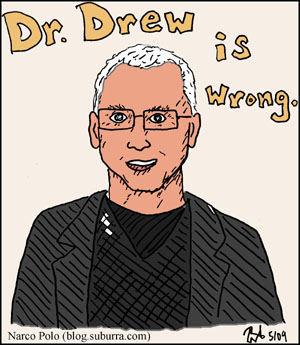 Dr. Drew Pinsky is a celebrity doctor who has doled out medical advice on the radio for over 25 years. He is now a media franchise and has become the nation’s popular expert on addiction with his television shows Celebrity Rehab and Sober House. Unfortunately, several of his proclamations are wrong.
Dr. Drew Pinsky is a celebrity doctor who has doled out medical advice on the radio for over 25 years. He is now a media franchise and has become the nation’s popular expert on addiction with his television shows Celebrity Rehab and Sober House. Unfortunately, several of his proclamations are wrong.
Willpower Does Work
Pinsky is a champion of the disease theory of addiction. In his words, “Addicts have intense neurobiological patterns in the brain that have a grip on them, and willpower doesn’t work.” (Hochman)
Studies have found the legal drug nicotine to be the most addictive substance. Yet roughly half of those who have ever smoked have quit without treatment. The percentage of former heroin, cocaine, and alcohol addicts who have quit without professional assistance is even higher. (Peele, p. 1)
As Dr. Stanton Peele, an addiction expert, explains, “an enormous treatment/recovery industry, backed by a large government bureaucracy” insists on perpetuating the myth that curing addiction cannot possibly take any route but their own. (Peele, p. 2)
The Damage Dr. Drew Causes
“Disease” centered treatment helps many people, however, by damning any other route to stability Dr. Drew does a great disservice. A 1996 study that tracked subjects in outpatient alcohol treatment found that “belief in the disease model of alcoholism” was one of two primary factors in predicting relapse. (Peele, p. 38)
This is common sense. If you brow beat someone into thinking they are a life-long addict with no will power is it surprising that they are more likely to behave like someone with no willpower?
Dr. Drew and Artie Lange
The addiction theory is an attractive concept to addicts as it excuses their actions and frees them from responsibility. But one addict who is not buying it is Artie Lange of The Howard Stern Show. (Read post about Lange’s addiction here.) On a Pinsky appearance on The Howard Stern Show (1/12/09) Pinsky said of Lange, “You have to see Artie as a heroin addict. Everything’s bullshit.” Lange responded re Pinsky’s rehab shows, “You wanna be famous and you’re exploiting people to get there.” Later adding, “[Pinsky’s] taking advantage of the biggest fuck ups in LA right now …. They’re not getting proper treatment.”
Lange has recently devised a new program for himself to stay off heroin which involves exercise and keeping two ex-cops by his side. Dr. Drew called Lange’s plans “self-will run riot” and said that as long as Lange is calling the shots for himself he will fail. Dr. Drew said Lange needs a six-month spiritual program of recovery and that his life depends on it. (Dell’Abate, 5/7/09) Lange was infuriated about this damnation and questioned Pinsky’s motives revealing that Lange had been offered $250,000 to do three weeks on Pinsky’s show, Celebrity Rehab.
Other Dr. Drew Myths
“Heroin addiction has a worse prognosis than cancer.” (Dell’Abate, 1/12/09) – A study of heroin users found the annual death rate to be 1%. Taken out of the criminalized context, in a three year heroin maintenance program with over 1,000 patients no one died.
“One out of ten heroin addicts beat it.” (Dell’Abate, 1/12/09) – I do not know Pinsky’s source but drug abuse studies are almost always skewed in that they focus on people in treatment. (Imagine how alcohol would be portrayed if all media and research coverage was of those in rehab.) One study that was drawn from a more general population of users was that of heroin addicts returning from Vietnam. Very few received treatment, and yet after leaving Vietnam only 12% continued to be addicted. (This cannot be attributed to availability as six in ten of those addicted in Vietnam used a narcotic after returning.) The relapse rate was actually higher for veterans who were treated for their addiction than those who were not.
If my kids ever did heroin I would load up their car with heroin and call the cops. (Dell’Abate, 1/12/09) – This claim led Lange to call Pinsky a “bullshitter.” I too question whether Pinsky would want his son to be imprisoned for years as a dealer and burdened with a criminal record so that every future employer would know about it. (How would George W. Bush and Barack Obama turned out if their relatives took the same tact with their cocaine use? LINK) As a public defender I saw many people who viewed drug use as a criminal matter quickly change their minds when their loved one was the one facing prison time.
“That part of the body wasn’t made for doing [anal sex], and I dread to see what will happen to these women down the line …. it won’t be pretty.” (Hochman) – According to Dr. Jack Morin, an expert in anal health, there is “no convincing evidence” that safe and responsible anal sex causes disease. (Morin, p. 223) In addition, the sphincter is a muscle and stretching it is no more damaging than stretching exercises are to any other muscles in the body.
More recent post on Dr. Drew Pinsky: Did Dr. Drew Lie About His Drug Use?
Sources:
- Robert Arthur, You Will Die: The Burden of Modern Taboos (2008).
- Gary Dell’Abate, The Howard Stern Show, Sirius XM Radio.
- David Hochman, “Playboy Interview: Dr. Drew Pinsky,” Playboy, 1 July 2008.
- Jack Morin, Anal Pleasure and Health (1998).
- Stanton Peele, Seven Tools to Beat Addiction (2004).

 (6)
(6) (2)
(2) (6)
(6) (6)
(6) (6)
(6)


 Dr. Drew Pinsky is a celebrity doctor who has doled out medical advice on the radio for over 25 years. He is now a media franchise and has become the nation’s popular expert on addiction with his television shows Celebrity Rehab and Sober House. Unfortunately, several of his proclamations are wrong.
Dr. Drew Pinsky is a celebrity doctor who has doled out medical advice on the radio for over 25 years. He is now a media franchise and has become the nation’s popular expert on addiction with his television shows Celebrity Rehab and Sober House. Unfortunately, several of his proclamations are wrong.